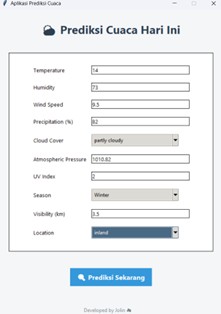Evaluating and Deploying Predictive Models for Weather Classification
DOI:
https://doi.org/10.63017/jdsi.v2i2.177Abstract
Weather is the condition of the atmosphere in a specific location over a relatively short period of time, described through various parameters such as temperature, air pressure, wind speed, humidity, and other atmospheric phenomena. It differs from climate, which refers to the average atmospheric conditions over a large area and a long time period studied under the field of climatology. Weather can vary from hot to cold, wet to dry, and windy to calm. It is influenced by dynamic changes in the Earth’s atmosphere, including warming and cooling processes. In recent years, weather changes have become more frequent and unpredictable, significantly affecting daily human activities. Therefore, an intelligent system capable of detecting and predicting weather conditions is increasingly needed. This study aims to apply classification algorithms to predict weather conditions based on relevant meteorological parameters. The algorithms used include k-Nearest Neighbor, Random Forest, Naïve Bayes, Decision Tree, and Deep Learning. Given the irregularity and complexity of weather patterns, manual prediction becomes unreliable. Although it is impossible to predict the weather with absolute certainty, computational methods can provide reasonably accurate estimations. Based on the evaluation results, the Random Forest algorithm demonstrated the highest accuracy among the tested models. Furthermore, the final model was successfully deployed using Python, enabling real-time predictions on incoming weather data.

Downloads
Published
How to Cite
Issue
Section
License
Copyright (c) 2025 Data Science Insights

This work is licensed under a Creative Commons Attribution-NonCommercial 4.0 International License.


 SUPPORT
SUPPORT







